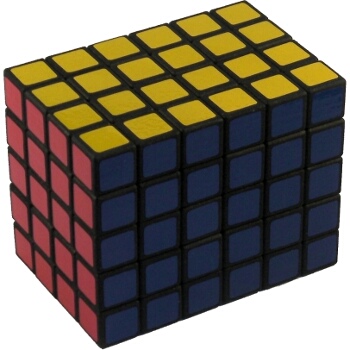
Above:Solved
Click a thumbnail to see its larger version and description.
The (fully functional) logical next step after 1x2x3, 2x3x4 and 3x4x5 cuboids.
After the creator has designed a 1x2x3 and a 3x4x5 this puzzle was "just" the next logical step although it needed a request of Sigurd Wedel before it could come to life.
It has 40 unique parts. Even though it is not noticable, the pieces are slightly unproportional to allow a more durable mechanism, corner stalks in particular. The edge cubies on 5 side are 13 x 14 mm and 8 corner cubies are 13.5 x 14 mm. It becomes even more unclear with completely square stickers.
The mechanism is a "standard" Fisher method for cuboids. The 4x5x6 has an internal modified 6x6x6 core which is similar to the 5x5x6 and TomZ's 4x4x6. If one understands how, for example, to make a 5x5x6 or 4x4x6 from a 6x6x6, does not need to invent a mechanism for a 4x5x6. A 6x6x6 modified with Fisher method and covered with the distinct cubies is pretty much the only possible mechanism for a 4x5x6. Jin H Kim's method (or Tony Fisher's earlier method for the 4x4x6) where the internal cube receives hooking pieces with the tongues (similar how on a ball-cored 4x4x4s) cannot be used for 2 reasons:
1) The corner stalks would be even smaller/thinner
2) The pieces on the babyfaces(if it is a 4x4x4 or a 4x4x5) would not go far enough into the core to prevent them from falling out during 30 degree moves. This has already happened on Tony Fisher's 4x4x6 and 2x2x7(where he used ball bearings to stop the pieces from falling).
Size: 56 x 66 x 83 mm
Weight: 125.5 grams
In 2021 Ilya Toporgilka started making a handmade version of a 4x5x6. His cuboid has cubies 1 mm bigger. He says it took him much longer to make than a 5x5x6. Images 8-11 show the building process:
Image 8: The core is a modified 6x6x6.
Image 9: 14 x 14 mm squares glued on
Image 10: Top squares are glued on
Image 11: 4 x 5 layers added. The inventor chose to leave gaps.
In 2023 Mohammad Badir presented a design printed in FDM instead of the SLS of the first version. See images 12-13.
Links

Contributors
Thank you to the following people for their assistance in helping collect the information on this page: Andreas Nortmann.
Collections
This puzzle can be found in collections of these members:
Found a mistake or something missing?
Edit it yourself or
contact the moderator.













